Valentines Day is here and this month on Naked Oceans we reveal some of the unusual mating habits of ocean animals. How do they track down a mate in the enormous oceans? What happens if they are stuck firmly in place on the sea floor? And what does all this mean for our efforts to protect ocean life? We find out what happens when the animals that build coral reefs take part in a huge, synchronised love-in. We call in on the Cayman Islands to discover how the spawning habits of many fish put them in grave danger of being overfished. And we find out how jellyfish make more jellyfish and whether these prolific beasties really are going to take over the oceans. Plus, we find out from a gender-bending Critter of the Month what life is like being both a male then female.
In this episode
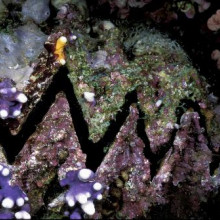
01:42 - Oysters in trouble
Oysters in trouble
Oysters are considered to be a culinary delicacy, but a new piece of research has found that 85% of all oyster reefs have been lost globally.
We're all familiar with the fact that overfishing is a problem, but this research has pointed out another marine ecosystem that's in trouble. Michael Beck and his colleagues estimated the condition of 144 bays and 44 ecoregions across the globe, based on current oyster productivity compared to historical records of catch, and aerial size estimates of the oyster reefs. In many places, historical records suggest that oysters had been abundant in the past - I mean, now oysters are considered to be a rather posh and fancy thing to eat, but they used to be so abundant that they were considered poor man's food.
They found that the condition of 70% of the bays and 63% of the ecoregions they studied was 'poor', which meant they had lost between 90 and 99% of their original abundance. They also found that, especially in Europe and North America, 37% of the oyster reefs were functionally extinct - suffering losses of over 99%. And it;s not just the oyster populations themselves that are suffering - they are important for the rest of the ecosystem too, filtering the water, providing food and the reefs themselves provide a structure and habitat for other species to live on. So when the oysters are lost, the whole ecosystem is in trouble.
The paper also goes on to suggest some conservation techniques that could be employed to help preserve reefs - some of the least affected reefs they studied were in ecoregions where there were marine management systems in place. So they suggest schemes like protected areas, managing the fisheries more closely, and even attempting to restore reefs as well.
So even though it's a worrying picture, there are some possible ways to improve the situation.
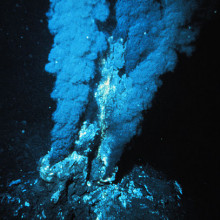
04:24 - World's first deep-sea mine
World's first deep-sea mine
We've come a step closer to seeing a brand new threat to the oceans - the government of Papua new Guinea has granted the world's first license to mine the deep sea.
Hydrothermal vents are weird and wonderful ecosystems fuelled by bacteria that harness chemical energy from mineral-rich water that gushes up through cracks in the seabed.
And the seabed surrounding them is laced with metals including gold, silver, zinc and copper. But only recently has the technology advanced far enough to make mining these valuable minerals into a reality.
Cindy Lee Van Dover from Duke University in the US, has written into the journal Nature raising her serious concerns that before the deep sea is opened up to wholesale commercial mining, proper conservation plans urgently need to be put in place.
She admits that she would rather see hydrothermal vents left well alone. But that's just not realistic given the relentless demand there is for minerals to fuel our gadget-hungry lifestyles.
Interestingly, she's been working with Nautilus Minerals - the Canadian company granted this first mining license - partly because she says it offers her the chance to do research that as an academic she wouldn't otherwise be able to afford.
We're still a couple of years off, but their plans are to dig 20-30m down into the seabed over an area equivalent to about 10 football fields. And they say they're going to leave a similar area of seabed nearby in a temporary marine reserve in the hope that it will help reseed the area they've mined.
But as Van Dover points out, at the moment we just don't know whether this is going to work. We still have virtually no idea what impact mining will have or how quickly hydrothermal vent ecosystems will recover.
A big problem here is that there are currently no regulations that oversee what goes on in the deep sea in international waters, where many hydrothermal vents are found.
And with several other nations and companies are showing interest in mining the seabed, we don't have long to figure this out.
Find out more
Cindy Lee Van Diver (2011). Tighten deep-sea mining regulations.
Nature.
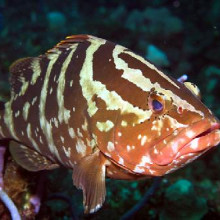
07:59 - A mating problem for Nassau groupers
A mating problem for Nassau groupers
with Brice Semmens, Reef Environmental Education Foundation (REEF)
Brice - The Nassau grouper is one of the larger Caribbean reef fish. It's a tiger-striped fish and it's really a Caribbean icon. It's one of those fish that you often seen framed in the wish-you-were here postcards that you may get from your friends in the Caribbean.
It's something that people really enjoy seeing on the reefs both because of its beauty and also because when you find a large fish like that on a reef it makes that reef feel a little bit more wild.
So typically Nassau grouper are solitary and territorial. So they defend areas of reefs. Once or twice during the year, shortly after the winter full moons, they get randy and they go about looking for mates.
The way that Nassau grouper do is, they will often swim over very large areas in order to get to one specific place on a reef. And many, many individuals will do that swim and gather together in these large aggregations or groups.
And during that winter full moon they will all spawn together. And when all's said and done they'll head back to their home reefs, back to their territories and go about their business.
Helen - Being so predictable in time and space, these spawning sites have historically been a major target for fisheries across the Caribbean. And that's causing serious problems for the Nassau grouper, isn't it?
Brice - There are lots of places now where they have been basically fished to exhaustion, they've been fished to the point where they're no longer worth fishing by the local fishermen.
Basically the way that that has proceeded is through fishing down these spawning aggregations. They are literally being serially depleted. And you can imagine when you get very valuable large fish and you get a whole bunch of them all in one location that's really an irresistible draw to fishermen. And so, when these aggregations are found, they're hit very hard until all of the fish that are there are virtually gone.
And what's really kind of scary about it is that in most of these places where this really heavy depletion or overfishing on spawning aggregations has happened there's very little evidence that recovery happens after the fact. So once you've fished out those spawning aggregations there's virtually no evidence that they recover.
So part of the reason that we're doing research down in the Cayman Islands is that, well, first of all it's one of the last places in the Caribbean that has a large healthy aggregation of Nassau groupers. But also it represents a great opportunity to start to investigate how aggregations happen. So getting some basic information on the natural history of Nassau grouper spawning aggregations. And also why it is that when these aggregations are fished to the pint of near exhaustion they don't recover.
Helen - And you've got this wonderful site, by the sounds of it, in the Cayman Islands where you do still have a large aggregation that's forming. How big is that aggregation? How many fish are we seeing there?
Brice - Well, as you can imagine, when you're trying to count fish on a very deep site it can be a challenge. So we're using a series of different techniques to try and get the answer to that question.
We're estimating somewhere in the ballpark of 3000 individuals. And to put that into perspective, when that aggregation was first found on the west end of Little Cayman, there was something like 7000 individuals.
And at the time that it was discovered by local fishermen it wasn't protected. And in the first two years, nearly half of the fish on that aggregation were fished out.
But the Cayman Islands was able to make a very, very rapid decision to conserve not just that spawning site, but in fact all of the spawning sites around the Cayman Islands - just happens that most of them had already been fished out so they're protecting these legacy sites. And so that's where the Reef Environmental Education Foundation came in, the REEF programme, and we started working with the Cayman Islands government, to, after the protections went into place, try to determine whether or not those protections were a) effective, and b) something that should be kept into the future, moving forward as a management conservation programme.
One of the basic research questions that we had is are these local fish? Where are these fish coming from? Where are they going to afterwards?
And it turns out that, based on the tagging work that we did, not only are all of the fish on the west end of Little Cayman that are showing up to spawn Caymanian fish, but they are in fact all only from the island of Little Cayman. And so we found that despite tagging in all three of the Cayman Islands, Grand Cayman, Cayman Brac, and Little Cayman, we found no evidence of any fish moving between islands over deep water.
So if you're conserving fish on spawning aggregations, you're conserving your local spawning stock.
What's also really important is that it turns out that basically every single reproductive-aged fish on the island of Little Cayman goes to the west end spawning site during the spawning season.
And so when you are fishing that spawning site you are basically exposing your entire sum reproductive potential for your spawning stock of fish, your whole population of fish, to harvest pressure.
Helen - It seems to make nothing but common sense that spawning aggregations should be protected. Is that something that we're seeing outside the Caymans? Are other spawning sites being protected from fishing pressure?
Brice - So one of the nice things that's happening throughout the Caribbean is that slowly but surely regional governments are sort of understanding that these spawning sties are important. Not just for Nassau grouper, but it turns out that all kinds of different species use the exact same location on the reef. For whatever reason, there's an importance of place where these spawning aggregations actually take place.
And so for the Caymans, for instance, so far we've documented something like 25 different reef fish species that are using the spawning site to reproduce. And so there is a movement to conserve these locations spatially to establish Marine Protected Areas.
In addition, for grouper species in particular there are efforts - for instance in the Bahamas and Bermuda - to disallow selling of grouper in restaurants and grocery stores during the time of year when they're reproducing. And it's a way of controlling the fishery during this important time.
Now it's important to know that no Nassau grouper has ever been seen to reproduce when they aren't at the spawning site. And what that means is that when they're spawning at the spawning site that is the only time during the year that they're ever reproducing.
So if you mess with that event you are cutting off, effectively, any reproduction in the population, which is a very dangerous thing to do.
Helen - Is this also a global problem that we're seeing in terms of the depletion and disappearance of spawning aggregations?
Brice - Spawning aggregations have, you know, it's something that's been going on for years, fishing spawning aggregations and fishing locations where fish get together in order to reproduce. There's big examples that people maybe don't really realise but cod is a great example in the Atlantic. Bluefin tuna in the Gulf of Mexico, that's a spawning aggregation. Fish from multiple stocks of bluefin tuna from as far away as the Mediterranean will come to the Gulf of Mexico in order to reproduce and there they are targeted for harvest.
So it's a common problem in fisheries in a global context and it represents both a management challenge and an opportunity once we understand reproductive behaviour of these species to conserve that reproductive potential of the population during very vital times, during their natural history.
Find out more
REEF
Grouper Moon Project
Nassau grouper(Epinephelus striatus) on Fishbase
Society for the Conservation of Reef Fish Aggregations
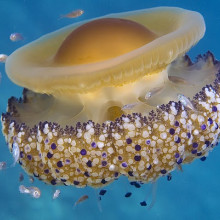
24:10 - Secret sex lives of Jellyfish
Secret sex lives of Jellyfish
with Cathy Lucas, National Oceanography Centre, Southampton, University of Southampton
Helen Scales hears how jellyfish reproduce from Cathy Lucas, National Oceanography Centre, University of Southampton...
Cathy - They breed in 2 different ways. They're life cycle consists of the jellyfish or the medusa that we're familiar with, swimming in the water. And they also have a polyp, a small things that looks like a sea anemone that lives on hard substances on the sea bed. There's not separate males and females but what they do is they clone or they bud off new polyps then at certain times of the year, mainly this time of the year certainly around the UK, they produce new baby jellyfish. And that's a process that we can strobilation.
 Baby jellyfish grow up through the spring taking advantage of the plentiful food. They grow very rapidly. And then in the late spring, early summer, these reproduce sexually. So we have separate sexes, a male and a female and these will produce eggs and sperm. And they release the eggs and sperm into the water column, the female will take up the sperm from the water column, the eggs will turn into a little larvae that swims around for a few days and then that settles back down onto the seabed and that metamorphoses into a polyp. And so the life cycle starts all over again.
Baby jellyfish grow up through the spring taking advantage of the plentiful food. They grow very rapidly. And then in the late spring, early summer, these reproduce sexually. So we have separate sexes, a male and a female and these will produce eggs and sperm. And they release the eggs and sperm into the water column, the female will take up the sperm from the water column, the eggs will turn into a little larvae that swims around for a few days and then that settles back down onto the seabed and that metamorphoses into a polyp. And so the life cycle starts all over again.
Helen - And we all know that the oceans are absolutely enormous. So, how do those free-swimming jellyfish, how do they actually find each other to reproduce sexually?
Cathy - Most jellyfish that we see, or by far the biggest abundances of jellyfish that we see tend to be found in estuaries and bays and enclosed areas. And so just the confined areas of those different sort of environments will tend to keep the jellyfish together in a physical way. They tend to be aggregated with tides and currents. And sometimes you find if there's very strong winds they tend to get blown into a certain area and that's quite often why we find jellyfish stranded on our beaches.
So the physically processes are quite a major factor in helping jellyfish populations to keep together. But there's also some aspects of behaviour that they can use. They're able to migrate up and down the water column, usually in response to light. And as a group of jellyfish they might migrate up to the surface and then migrate back down. Although they're very simple organisms they do have some sort of sensory capacity and so, it's a sort of a mixture of the physical properties of the water and maybe what the weather's doing, and also there's some sort of behavioural adaptations as well.
Helen - Over the past few years, we're heard more and more about the rise of slime, with the explosion of jellyfish in particular parts of the ocean. Where are we seeing these blooms and what sorts of problems are they causing?
Cathy - Yes, there has been a big increase in both the scientific and media reports  concerning the increase in jellyfish numbers. And, there are some particular hotspots that are being quite well documented. And these include the Mediterranean and there have been quite a few incidences in the last 5 to 10 years where a lot of jellyfish have washed up on beaches and they cause nasty stings so they have to close the beaches there.
concerning the increase in jellyfish numbers. And, there are some particular hotspots that are being quite well documented. And these include the Mediterranean and there have been quite a few incidences in the last 5 to 10 years where a lot of jellyfish have washed up on beaches and they cause nasty stings so they have to close the beaches there.
In the 1980s there was a classic example of a proliferation of not a true jellyfish but a thing called a sea gooseberry or a ctenophore that had been transported over from North America into the Black Sea and it exploded in numbers and caused real problems there.
There's also problems in Southeast Asia around Japan and China with the giant jellyfish that can be absolutely vast, two metres in diameter. And that's causing a lot of problems for their fisheries there.
And then also, the Benguela upwelling, which is on the Southwest African coast, that's a very important area for fisheries, and partly because of overfishing there's been an explosion of jellyfish that have appeared in that sort of environment.
Helen - We see that jellyfish have this ability to increase their numbers pretty rapidly. Presumably their mode of reproduction has a part to play there, does it?
Cathy - Jellyfish in general are very opportunistic. They have enormous appetites, so they can consume large amounts of plankton and they grow extremely rapidly. And also their life cycle is relatively short. So, within 4-6 months you can go from a newly released jellyfish up to a fully grown sexually mature adult jellyfish. You know each polyp can produce many baby jellyfish, and in the polyp population there might be thousands, or tens of thousands of polyps living on the seabed.
And also the jellyfish themselves are producing thousands of eggs and sperm. And so, they have the potential in both phases of the life cycle, to produce vast amounts of new jellyfish.
And so definitely reproduction is a big part of their success but it's just part of their biological make up, there's the growth, and there's the feeding rate as well.
Helen - But they can definitely get those swarms going if they can to.
Cathy - They certainly can.
Helen - And in terms of the swarms of jellyfish that we're seeing at the moment, happening around the world, what is the feeling about that - is it a global phenomenon, a sign of long term change in the oceans? Is that really playing out in what you're seeing?
Cathy - I'm actually part on an international project that's examining in a way, these  very questions of is the global expansion of jellyfish blooms really happening? And if so, what is the magnitude of that? What are the causes and what are the consequences of that?
very questions of is the global expansion of jellyfish blooms really happening? And if so, what is the magnitude of that? What are the causes and what are the consequences of that?
Our primary goal that we've been working on over the last 12 months is actually to collate all the data that we can get our hands on of jellyfish abundance and appearance from as many regions of the world as we possibly can. So then we can start to say, okay, are these natural cyclic phenomena, or is it actually genuinely expanding?
And so we've been compiling a global database of jellyfish abundance, it's called Jedi and we've been using published data, extracting data from long term monitoring programmes, going through historical records, cruise logs, and also using fisheries bycatch data and as well as public sightings, so if people have been to the beach they can enter their sightings in the database and we can use that as well.
Find out more
Jellywatch website
Cathy Lucas,
National Oceanography Centre, Southampton
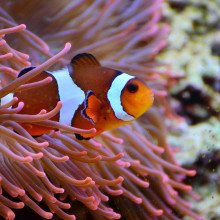
31:20 - Critter of the Month - Clown Anemone Fish
Critter of the Month - Clown Anemone Fish
with Peter Buston, Boston University
A gender-bending critter reveals what life is like as a male and then female. Made famous as Nemo... it's the anemonefish.
Peter - My name is Peter Buston, I'm assistant professor in marine biology and evolutionary ecology at Boston University. And the critter that I've worked on for a very long time is the clown anemone fish, made famous by the movie Nemo.
They're always found in close association with giant tropical sea anemones, which areabout, on average about half a metre across. The anemones provide the fish with everything they need. They provide them with protection from predators, a place for the fish to lay their eggs, and they never stray from the anemone's tentacles.
So within each anemone there's a single group of clownfish, anywhere from 3 to 6 individuals. The largest is always the female, and she's dominant to everybody else. The 2nd largest is the male. And the 3rd largest is a non-breeder, it's neither reproducing as a male nor as a female. The same goes for the 4th, 5th, 6th individual.
If we start from the bottom there's a queue for breeding positions so these non-breeders are waiting in line to inherit breeding positions. Lower ranked individual remains small, it remains 80% of the size of the immediate dominant. And it remains small because if it gets any bigger, the dominant will evict it.
If, for instance, the female of the group dies, then the male will change sex and take the position of the female. And the largest non-breeder, that's the one at the front of the queue will start breeding as a male and everybody else moves one up in the queue. It sometimes takes them 10, 15, 20 years to inherit a breeding position, but it's the best way of going about it because there are no breeding positions vacant elsewhere, because all the sea anemones are occupied and all the sea anemones have a little queue like this going on.
The species is really easy to work with. You can go onto the reef and you can map out all of the anemones and you can go back and find the fish exactly where you left them the day before. You can identify individuals based on natural variation in their markings the same way that you tell your friends apart. I was able to tell apart 350 individuals in the population.
They're super-photogenic so if you go down onto the reef, even with all the other colours around these clown anemone fish really stand out. There's loads of interesting questions but also you can do very cool, long term observations of a known population of individuals. And that's what attracted me to working on them.
- Previous Asthma, Pool Cleaners and MRSA
- Next Smart Way to Rehab










Comments
Add a comment